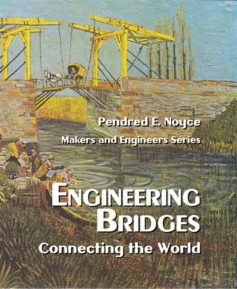 Teacher & Student / After School Activity Plans Relating to: Engineering Bridges: Connecting The World
Teacher & Student / After School Activity Plans Relating to: Engineering Bridges: Connecting The World
by Pendred Noyce
About the Book:
This book fills a gap between picture books for elementary students and technical books about bridges at the college level. It provides a readable and comprehensive illustrated guide to bridges of the world, with attention to different designs (arch, beam, truss, cantilever, suspension, cable-stayed) and materials (wood, stone, iron, steel, concrete, and even roots, grass, and plastic). Design challenges, technical advances, and environmental concerns are addressed with examples drawn from across the world and across the centuries. Fun chapters include those on movable bridges, pedestrian bridges, and bridge disasters. The style is friendly and accessible.
Why We Did This Book:
We created this book because we felt that although there are a number of books about bridges, we wanted to bring readers a fun and engaging way of learning about bridges from around the world, with unique insights about technologies that evolved over time. We also wanted to develop a book that follows closely along with lesson plans and activities, that we are constantly developing, and which we want students around the world to learn from, and enjoy. Bridges are an essential part of every civilized human society, and in many cases, bridges can enable the survival of communities as well as entire nations. The inspiration behind this book is the 100th Anniversary of Mao Yisheng – China’s most well known bridge maker, who was the first Ph.D. graduate from Carnegie Mellon University. His work has inspired generations of bridge builders — as well as students who study STEM subjects in general, throughout the world. His story is a unique one, which “bridges” the educational cultures of both the US and China. In his spirit, we hope that students around the world will be inspired to learn more about engineering, and strive to work together to solve major problems that face all of us.
Our Collaborators:
The book was developed in association with the Carnegie Mellon University Gelfand Outreach Center, as well as the Mao Yisheng Foundation in Beijing, China. Additional partners include the US China Scitech Education Promotion Association as well as Shangde Group, of China.
Activities & Lesson Plans:
In the near future, we hope to have a bunch of activities and lessons posted here, for you to do in your classroom and in your home and to share with others! In addition, we encourage you to visit our partner Carnegie Mellon University Gelfand Center’s website, to see their bridge activities too.
Check out these awesome bridge-related resources and activities for a range of different ages, developed by the Carnegie Mellon Gelfand Center:
https://www.cmu.edu/gelfand/lgc-educational-media/bridges-and-structural-engineering/page.html
Use CODAP to Analyze Bridge Failure Data Online:
Use our partner Concord Consortium’s CODAP (Common Online Data Analysis Platform) free online software tool to view data about different bridges across the state of Maine, and how their failures can help you to predict future problems and prevent them. It’s a fun, interactive tool that lets you play with the data, and see how it responds. Check it out:








